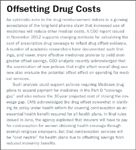Costs and Coverage Challenge Medicare Drug Plans
Pharmaceutical Executive
Rate cuts and fraud concerns create problems for Part D plans and Part B providers.
Medicare Part D either is the most effective recent government health program—providing low-cost access to important medicines for 37 million seniors—or a program open to abuse and uncontrolled costs that has to be reined in. As the Obama administration struggles to roll out its landmark health reform initiative this fall, analysts are looking at Part D as a model for marketing private plans to millions of consumers, as well as a cautionary example of what can go wrong.

Jill Wechsler
Those who orchestrated the Part D launch in 2006 recall widespread fears that insurers would shy away and that beneficiaries would not sign up. Democrats were furious that Republicans had pushed through a market-based program and predicted dire results. Despite initial glitches in computer systems and pharmacy operations, the program is a clear success and has cost the government and beneficiaries much less than originally estimated. The savings result partly from fewer people signing up than anticipated, plus a broad drop in drug costs as fewer new therapies came to market and generic prescribing took off. But competitive plans also deserve credit for promoting generics and for negotiating low prices from manufacturers.
Costs and coverage
Now intense federal budget cutting is prompting closer scrutiny of Medicare outlays for drugs, which total about $70 billion a year for some 1 billion prescriptions. Pharma companies are concerned that plan sponsors are limiting coverage to reduce outlays, as seen in a study by Avalere Health for drugmaker UCB documenting that Medicare plans cover fewer anticonvulsant drugs and impose higher cost-sharing than commercial insurers.
Critics, however, are demanding stronger management of pharmacy benefits to prevent inappropriate prescribing of antipsychotics and other drugs, as described in a May report from Pro Publica (see Pharm Exec, "Washington Report," June 2013]. The public interest health researchers also have documented a link between high Medicare physician prescribing and the fees they get from pharma marketers.
Similar issues were raised in a June report from the HHS Office of the Inspector General (OIG) documenting millions in drug program overpayments, underpayments, and undocumented expenditures by Medicare drug programs, largely related to the opioid abuse epidemic and associated fraud and waste. The report uncovered more than 700 doctors with "questionable Medicare Part D prescribing patterns" in 2009, in line with earlier OIG reports documenting inappropriate Part D refills, claims with invalid prescriber identifiers, and questionable billing by retail pharmacies. The Senate Committee on Homeland Security and Governmental Affairs examined these issues at a June hearing where OIG officials further described fraudulent Medicare outlays for prescription painkillers, as well as extensive prescribing by unauthorized practitioners such as massage therapists and home care contractors. Officials from the Centers for Medicare and Medicaid Services (CMS) said they were addressing these problems, but Congress may seek further remedies: Rep. Frank Pallone (D-NJ) has proposed legislation requiring Part D sponsors to verify that an authorized physician issued the prescription for a controlled substance and to restrict access to opioids for patients showing signs of abuse.
The Senate Special Committee on Aging, moreover, is examining Part D marketing and has asked the Government Accountability Office (GAO) to examine how well plan sponsors provide accurate pricing and coverage details to seniors. Aging Committee chairman Bill Nelson (D-FL.), along with most Democrats, continues to press for pharma companies to pay Medicaid rebates on medicines provided to low income "dual eligible" Medicare beneficiaries, who now receive drug benefits under Part D. Such targeted rebates, according to Congressional Budget Office (CBO) analysts, would cut spending by some $140 billion over 10 years, but probably lead to higher prices on new drugs overall.
Fixing Part B
Medicare spends about $20 billion a year on drugs administered by doctors, but that could soar with approval of more high-priced therapies for cancer and other critical diseases. Fears of unsustainable program costs thus is focusing policy makers on use of particularly high-cost therapies to treat cancer, autoimmune disorders, and chronic kidney disease, such as the 55 high-volume therapies that account for most Part B spending, as documented in another GAO report.

Offsetting Drug Costs
This finding was discussed at a June hearing by the House Energy & Commerce Health subcommittee, along with proposals to fix some of the anomalies in the Part B drug reimbursement formula, now set at 106 percent of average sales price. Physicians complained about losses due to the practice of including prompt pay discounts in rate calculations, plus the half-year lag for CMS to update prices, which leaves providers holding the bag for months. The current sequestration process, with its 2 percent across-the-board cut in Medicare funding, has generated ever louder protests from oncologists, who claim they're losing so much money that they will have to send more patients to hospital clinics for treatment. And that's much more costly for Medicare and often more difficult for patients.
Separately, CMS has proposed to slash reimbursement for kidney dialysis centers by 9.4 percent next year. That means a 12 percent cut in rates for Epogen and other drugs administered as part of kidney dialysis treatment. These reductions come on top of the 2 percent sequester reduction, plus the prospect of additional adjustments in CMS' base payment for these drugs to reflect lower recommended dosages.
Most damaging for pharma, though, is CMS denial of coverage for a new therapy altogether. Eli Lilly was rocked last month by a CMS draft proposal to authorize only coverage with evidence development (CED) for Lilly's Alzheimer screening product Amyvid. That means providing the PET imaging drug only to Medicare beneficiaries who enroll in clinical trials designed to produce more evidence that this type of diagnostic screening is worth the money. Lilly and Alzheimer patient groups are lobbying hard for CMS to be more generous in its final reimbursement decision this fall, warning that restricting coverage could "stifle future innovation aimed at improving diagnosis" of this serious condition.

Jill Wechsler is Pharm Exec's Washington correspondent. She can be reached at jwechsler@advanstar.com.

FDA Approves AbbVie’s Rinvoq as First Oral JAK Inhibitor for Giant Cell Arteritis
April 30th 2025AbbVie secures FDA approval for Rinvoq as the first oral Janus kinase inhibitor indicated for giant cell arteritis, expanding its immunology portfolio and signaling strategic growth opportunities in underserved autoimmune markets.
Navigating Distrust: Pharma in the Age of Social Media
February 18th 2025Ian Baer, Founder and CEO of Sooth, discusses how the growing distrust in social media will impact industry marketing strategies and the relationships between pharmaceutical companies and the patients they aim to serve. He also explains dark social, how to combat misinformation, closing the trust gap, and more.